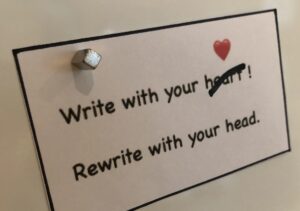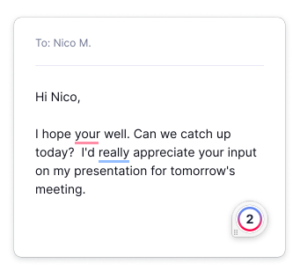 In the 2000 film, Finding Forrester, Sean Connery played the fictitious author William Forrester, described by the Washington Post as “a cross between Howard Hughes and J.D. Salinger.”
In the 2000 film, Finding Forrester, Sean Connery played the fictitious author William Forrester, described by the Washington Post as “a cross between Howard Hughes and J.D. Salinger.”
In the movie, Forrester supposedly wrote the great American novel Avalon Landing, his first and only book, and one that took the Pulitzer Prize.
While the movie is about a fictional author and a fictional book, Forrester gave some sage advice to his student protégé:
You must write your first draft with your heart. You rewrite with your head. The first key to writing is…to write, not to think!
I encourage those who take my memoir course to adhere to this advice, to let their thoughts and memories flow like a draft of air through an open window. Don’t think. Don’t correct. Don’t criticize yourself as you write. Just transfer the thoughts in your head to the paper or computer.
A draft is a preliminary sketch. It’s okay if it is rough and unpolished. Much work remains, of course. But much help is available, and some of it is free!
Three free online apps that I use between draft and final manuscript are Aztekera, Hemingway, and Grammarly.
Aztekera
 Kaye Linden told me about Aztekera when I was a member of her WAG critique pod, the Critters. The app identifies to-be verbs (be, being, is, was, were, etc.). My pieces had lots of them.
Kaye Linden told me about Aztekera when I was a member of her WAG critique pod, the Critters. The app identifies to-be verbs (be, being, is, was, were, etc.). My pieces had lots of them.
Sometimes, of course, to-be verbs are absolutely necessary and sometimes preferred. The use of a to-be verb does not necessarily constitute passive voice. But using too many can weaken the impact of our writing. Aztekera’s identification of all to-be verbs makes it easier for the writer to decide if any can be replaced. For example:
Passive: The venue for the wedding was chosen by Mary.
Active: Mary chose the venue for the wedding.
You’ll note that active voice will often shorten the sentence, as in the above example.
To check out the app, go to Aztekera.com, paste a block of your text into the block, and click “check” at the bottom of the page. Phrases or sentences with to-be verbs will be listed in red below the block. It will also tell you how many to-be verbs were used and the percentage. Aztekera states that the goal is to have no more than 20% to-be verbs in your writing.
Hemingway
 This app takes its name from Ernest Hemingway, whose writing style is often described as direct, clear, and fresh. The app highlights (color codes) confusing sentences, the overuse of adverbs, and passive voice. It also provides an analysis of the readability or grade level of the writing.
This app takes its name from Ernest Hemingway, whose writing style is often described as direct, clear, and fresh. The app highlights (color codes) confusing sentences, the overuse of adverbs, and passive voice. It also provides an analysis of the readability or grade level of the writing.
To check your writing, simply replace the sample text on the website page at Hemingwayapp.com with a block of your own text.
A free app and a paid app are available. I use the free one, but you can read about both here: https://blog.reedsy.com/hemingway-app-review/
Grammarly
 This one checks your typing—even emails and text messages—as you write. It highlights words it thinks are incorrect (see examples in the block below).
This one checks your typing—even emails and text messages—as you write. It highlights words it thinks are incorrect (see examples in the block below).
You may prefer not to use Grammarly while pounding out your first draft because it can be distracting. But I find that it is a time-saver when polishing my manuscript.
 Also, writers must keep in mind that the words the app highlights are not always incorrect. As examples, the app will highlight your and you’re as well as its and it’s. The writer must decide which is correct.
Also, writers must keep in mind that the words the app highlights are not always incorrect. As examples, the app will highlight your and you’re as well as its and it’s. The writer must decide which is correct.
Unlike Microsoft Word’s auto-correct feature, Grammarly does not make corrections for you, and I like that. When I typed the name Forrester in the first line of this blog post, Microsoft’s Word auto-corrected it to Forestry. You have to watch auto-correct or it will make you illiterate.
As for Grammarly, I started with the free version. But a full explanation and comparison of the free version versus the premium version is available at https://prowritingaid.com/grammarly-free-vs-premium, a blog post from ProWritingAid, another free writing resource. I have not used ProWritingAid, but you might want to check it out.
If you have used other apps you have found helpful, please share them with others by leaving a comment below.
[Editor’s note: WAG would love to see articles on any and all topics of interest to writers. Please send your ideas or finished pieces to Cynthia D. Bertelsen at BlogEditor@writersalliance.org for consideration. Remember: these posts are more than just posts, for they are actual articles and can be cited in your CV/résumé in the same way you would a short story, essay, or any other writing credit you may possess.]

Jenny Dearinger
Very enlightening! I did not know about these aps or how to use them. I have a pet peeve about to-be (dead) verbs when they can be changed into an action. I will certainly take advantage of these free sites. Thank you for sharing!
Mary Bast
So useful, Susie; thanks! I’ve used Aztekera occasionally since Kaye told us about it, but I haven’t tried the other two. I’ve bookmarked them for future reference.
Barbara Bockman
Thanks, Susie, for this information. I put a passage in Hemingway and got back a good response.
Bonnie T Ogle
You brought back good memories of Kay and the Critters! So funny, we were just explaining poor and over-use of to be to one of our Pod members. It was a good reminder to me, myself and I! Thanks for taking the time. I had forgotten about these sites and didn’t know about Hemingway!